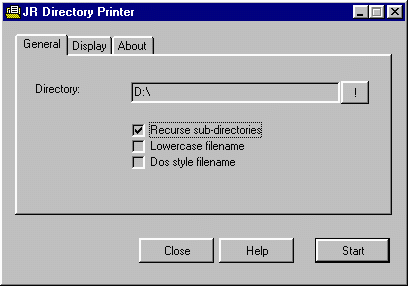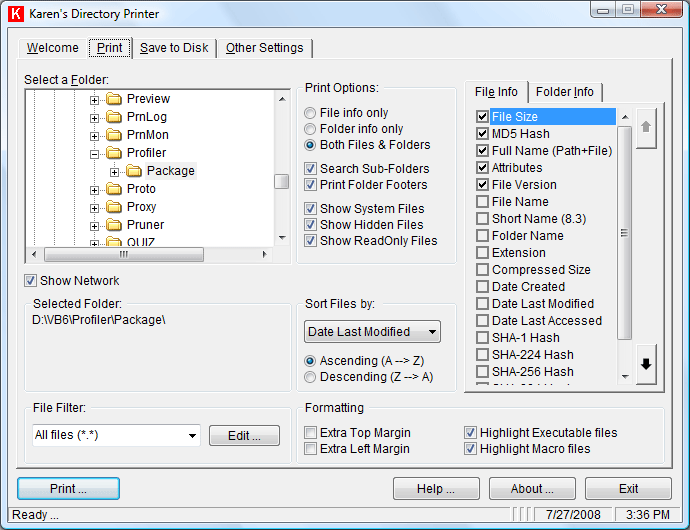Use the old Dos command tree
Run cmd.exe
Type
tree > c:\tree.txt to save it to a text file. If you just open that up in notepad the characters might look all garbled, but if you open it in MS Word and say to use DOS Encoding, then everything should look just fine.
tree /a >d:\tree.txt
The /f flag on tree displays all of the contents of the subfolders as well.
tree /f > d:\tree.txt
To just tree from a certain directory, you have to type
tree [directory name]not just run the program from that directory.
-------------------------------
Use the dir command, pipe it to a file, and print the file.
The /d switch only displays the filenames and directory names of Z: (directories in []'s).
The /s switch breaks everything down and displays all of the contents of all of the subdirectories.
dir /d /s Z:\ > X:\mydir.txt
-------------------------------
Use the screen capture utility HyperSnap.
You can capture a region of the screen by dragging a boundary area with your mouse, or you can get the whole listing by capturing with its autoscrolling feature (a window larger than 1 screenful will automatically scroll the capture area for you).
--------------------------------
PrintFolder - when it's installed, you seee PrintFolder as one of the options when you right-click on a directory in Windows Explorer. Does folders and subfolders
--------------------------------
SysExporter, too, is a super-useful program.
---------------------------------
Any serious drive reorganization effort will also be helped by SpaceMonger. You can see at a glance where all the big stuff is hiding.
=================
Source
The JR Directory
Printer Utility allows you to print a listing of every file
contained within a directory and/or subdirectory(ies).

The result
displayed in NotePad or default text editor as
"dirprint.txt" file. This file is created in "JR
Directory Printer" installtion folder, each time you click
"Start" button.
Options:
Check Recurse
Sub-directories option to see a complete list of all
subdirectories and all files in all directories.
The Lowercase
Filename option will force all file names into lowercase
regardless of the actual file name.
Dos style
filename option will limit the file name length within 8
chars.
Display
Sub-directories will result in a list of all subdirectories
contained under the selected directory along with a list of all
individual files contained under the root directory. It
will not list all subdirectories or individual files contained in
the main subdirectories. To see a complete list of all
subdirectories and all files in all directories, you would check
the Recurse Sub-directories option and click on the Start
button. This would rewrite the"dirprint.txt" file using
the new options.
You can limit
length file names so that they fits properly in list. By
default this value is 35 chars.
You can
check/uncheck Display Size, DateTime and Attributes option
to list/unlist the file size, modified date/time and file
attributes (a - Archives, r - Read Only, s - System, h - Hidden).
Download (size: 173 KB) ==========================
Source
Directory Printer v5.3.2
** Updated November 5, 2009

No more fumbling with My Computer or Windows Explorer,
wishing you could print information about all your files.
Karen's Directory Printer can print the name of every file
on a drive, along with the file's size, date and time of last
modification, and attributes (Read-Only, Hidden, System and Archive)!
And now, the list of files can be sorted by name, size, date created,
date last modified, or date of last access.



 LibreOffice
LibreOffice Firefox
Firefox
No comments:
Post a Comment